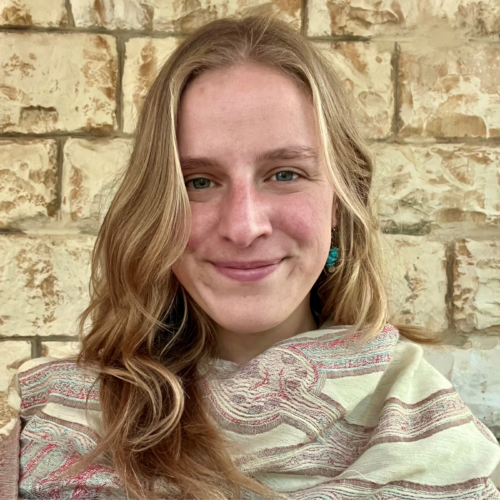
On Saturday, I watched as tears streamed down the faces of worshipers, their hands holding candles alight with the Holy Fire; shouts of joy that the “Messiah is risen, indeed” filled the Church of the Holy Sepulchre.

Lauren Draper
Holy Saturday, or Sabt Al-Noor (literally Saturday of Light) as it is referred to in Arabic, is a sacred day in the Orthodox Christian tradition because it is the only day of the year when the Holy Fire — the fire that miraculously lights the tomb of Christ in the Church of the Holy Sepulchre — gets spread out into the world. Priests from various Orthodox traditions receive the light from a flame in the recesses of the tomb in the ancient church and pass it along to gathered worshipers throughout the church and the streets of the Old City of Jerusalem. The beautiful and powerful image of candles burning throughout the sacred city symbolizes how Christ’s light is spread into the world.
This Easter season, I was privileged to worship alongside my Arab Christian brothers and sisters in Jerusalem. I was one of the hundreds admitted into the church, each wearing neon wristbands in Hebrew script that read “Shabat Ha-Or 2024.” Over the last four years, the Israeli Authorities have imposed strict restrictions on Holy Light Ceremony in the name of fire safety. The historic Christian event was attended yearly by over 10,000 individuals until 2021, when it was restricted to a mere 1,800 worshipers and 200 police.
Christians in the Holy City of Jerusalem feel increasingly pressured by ever-shrinking permissions for worship and increased expulsion from the historic birthplace of our faith. Primarily Orthodox, Christians once made up more than 18 percent of the local population of historic Palestine when Israel was founded in 1948 — but now constitute less than two percent.
As I processed through the Old City on Holy Saturday, I was struck by how the day could be viewed as a microcosm of the daily challenges experienced by Christian Palestinians living in this land. When security forces, police, and the Israeli army blocked entrances to the Old City, it offered a small glimpse of the harsh realities of the occupation of East Jerusalem, the West Bank, and Gaza. Almost all West Bank Palestinian Christians who wanted to make the few-mile pilgrimage to worship in Jerusalem were not allowed to travel through the nearby checkpoints in Ramallah and Bethlehem. Even as Christians in Jerusalem flocked to the Old City to participate, hundreds of local worshipers were also prevented from entering the Old City and passing through its ancient stoned streets.
If one was lucky enough to be allowed through one of the barricades, another was located just around the corner, only a few dozen yards down one of the winding streets of the Old City. Signs greeted worshipers in Hebrew, English, Greek, and Arabic all along the route: “The Israel Police wishes a happy holiday to the Christian people in Israel and all the world on the occasion of the Holy Fire.” The signs contradicted the reality playing out in front of our eyes, as worshipers attempting to reach the Christian landmark of the Church of the Holy Sepulchre pleaded with the security forces to be allowed passage. Some cried while others implored, each hoping to see the Holy Fire spread from its origin at the church.

Christian pilgrims hold candles during the Holy Fire ceremony, a day before Easter, at the Church of the Holy Sepulcher, where many Christians believe Jesus was crucified, buried and resurrected, in Jerusalem’s Old City, Saturday, May 4, 2024. (AP Photo/Ohad Zwigenberg)
Before the miracle of the Holy Light takes place inside the Edicule, the Greek Orthodox Patriarch of Jerusalem, His Beatitude Theophilos III, processes into the cathedral. This year, one could not miss the symbolism of Israeli police officers obscuring the view of the church leader. Yet despite the military presence and the physical obstacles placed along the pathway of the worshipers, it was impossible to prevent the spreading of the Light when it occurred.
As the Holy Fire passed by, crowds of people gathered behind the many barriers reaching out their hands filled with candles to receive the flame. Men, women, and children clapped, cheered, and celebrated as candles were shared flame to flame and the light was spread.
For the rest of my life, I will carry with me the image of Christian worshipers reaching out toward one another, internationals and local Palestinians alike, exuberantly stewarding candles holding a sacred flame, sharing that light neighbor-to-neighbor with one another. In a matter of moments, the entire path was full of singing and worship. The light that burned radiated a powerful heat that physical obstacles and barriers could not contain. By the power and grace of the Holy Spirit, may the church be inspired and compelled to spread the light of Christ in our homes, churches, and communities regardless of any barriers and injustices that might stand in our way.
Lauren Draper is the manager of communications for Churches for Middle East Peace (CMEP) and is based in Jerusalem.






